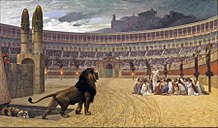This article needs additional citations for verification. (September 2020) |
Year 303 (CCCIII) was a common year starting on Friday of the Julian calendar. It was known in the Roman Empire as the Year of the Consulship of Diocletian and Maximian (or, less frequently, year 1056 Ab urbe condita). The denomination 303 for this year has been used since the early medieval period, when the Anno Domini calendar era became the prevalent method in Europe for naming years.
| Millennium: | 1st millennium |
|---|---|
| Centuries: | |
| Decades: | |
| Years: |
| Gregorian calendar | 303 CCCIII |
| Ab urbe condita | 1056 |
| Assyrian calendar | 5053 |
| Balinese saka calendar | 224–225 |
| Bengali calendar | −291 – −290 |
| Berber calendar | 1253 |
| Buddhist calendar | 847 |
| Burmese calendar | −335 |
| Byzantine calendar | 5811–5812 |
| Chinese calendar | 壬戌年 (Water Dog) 3000 or 2793 — to — 癸亥年 (Water Pig) 3001 or 2794 |
| Coptic calendar | 19–20 |
| Discordian calendar | 1469 |
| Ethiopian calendar | 295–296 |
| Hebrew calendar | 4063–4064 |
| Hindu calendars | |
| - Vikram Samvat | 359–360 |
| - Shaka Samvat | 224–225 |
| - Kali Yuga | 3403–3404 |
| Holocene calendar | 10303 |
| Iranian calendar | 319 BP – 318 BP |
| Islamic calendar | 329 BH – 328 BH |
| Javanese calendar | 183–184 |
| Julian calendar | 303 CCCIII |
| Korean calendar | 2636 |
| Minguo calendar | 1609 before ROC 民前1609年 |
| Nanakshahi calendar | −1165 |
| Seleucid era | 614/615 AG |
| Thai solar calendar | 845–846 |
| Tibetan calendar | 阳水狗年 (male Water-Dog) 429 or 48 or −724 — to — 阴水猪年 (female Water-Pig) 430 or 49 or −723 |

Events
editBy place
editRoman Empire
edit- Great Persecution: Emperor Diocletian launches the last and largest major persecution of Christians in the Empire. Caesar Galerius and Hierocles are said to have been the instigators. In a series of four edicts published from February 23, 303, to 304, the Christians are forbidden to worship in groups, are made to perform sacrifices, and must surrender sacred texts. Churches are destroyed, and the clergy are arrested en masse. The persecution lasts in some parts of the empire until 313, and thousands of Christians are killed. Those put to death include Agnes of Rome, a 12-year-old Christian girl who has refused marriage and consecrated her virginity to God. Hailed as a martyr, she will be honored as the patron saint of chastity, gardeners, rape victims and virgins.
- September 25 – On a voyage preaching the gospel, Saint Fermin of Pamplona is beheaded in Amiens (Modern day France).
- November 20 – The Augusti Diocletian and Maximian reunite in Rome to celebrate the 20th anniversary of Diocletian's accession, which is now treated as a joint anniversary for both emperors. A series of columns in the Roman Forum and a triumphal arch are dedicated to the emperors. The two emperors also agree on a plan of abdication.
- Galerius wins his third victory over the Carpi and is perhaps joined on campaign by Diocletian. The Arch of Galerius is dedicated in Thessaloniki.[1]
- Caesar Constantius I wins a victory over Germanic invaders in the battle of Vindonissa.
Armenia
edit- Etchmiadzin Cathedral is completed by Gregory the Illuminator and Tiridates III, king of Armenia.
- January 6 – Baptism of Tiridates III of Armenia.
America
edit- In Mexico, the civilization of Teotihuacan flourishes.
By topic
editReligion
editBirths
edit- Magnentius, Roman usurper (d. 353)[2]
- Wang Xizhi, Chinese calligrapher (d. 361)
- Xun Guan, Chinese warrior and general [3]
Deaths
edit- April 23 – George of Lydda, Roman soldier and martyr
- Acacius of Byzantium, Roman centurion and martyr
- Anthimus of Rome, Christian priest and martyr
- Cao Huan, Chinese emperor of Cao Wei (b. 246)
- Cessianus, Christian child martyr
- Crescentinus, Roman soldier and martyr
- Cyriacus, Roman nobleman and martyr
- Devota, Corsican woman and martyr
- Erasmus of Formiae, Christian martyr
- Expeditus, Roman centurion and martyr
- Felix and Adauctus, Christian martyrs
- Fermin, Christian bishop and martyr
- Lu Ji, Chinese general and writer (b. 261)[4]
- Li Liu, Chinese spiritual leader (b. 248)
- Li Te (or Xuanxiu), Chinese general
- Pantaleon, Christian wonderworker and martyr
- Romanus of Caesarea, Christian martyr
- Victor Maurus ("the Moor"), Christian martyr
- Vitus (or Guido), Christian martyr
References
edit- ^ Tuck, Steven L. (2015). A History of Roman Art. John Wiley & Sons. p. 313. ISBN 978-1-4443-3026-7.
- ^ Vagi, David (2016). Coinage and History of the Roman Empire. Routledge. p. 476. ISBN 978-1-135-97125-0.
- ^ Lee, Lily Xiao Hong; Stefanowska, A. D.; Wiles, Sue (March 26, 2015). Biographical Dictionary of Chinese Women: Antiquity Through Sui, 1600 B.C.E. – 618 C.E. Routledge. p. 366. ISBN 978-1-317-47591-0.
- ^ "Lu Ji's (261–303) Essay on Literature dated 1544 and 1547". www.metmuseum.org. Retrieved January 5, 2020.